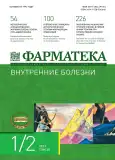Vertebrogenic cervical radiculopathy: modern approaches to diagnosis and treatment
- Authors: Levin O.S.1,2, Nikitina A.Y.1, Nebozhin A.I.1
-
Affiliations:
- Russian Medical Academy of Continuous Professional Education
- S.P. Botkin City Clinical Hospital
- Issue: Vol 30, No 1/2 (2023)
- Pages: 197-202
- Section: Neurology
- Published: 15.06.2023
- URL: https://journals.eco-vector.com/2073-4034/article/view/462784
- DOI: https://doi.org/10.18565/pharmateca.2023.1-2.197-202
- ID: 462784
Cite item
Abstract
In terms of frequency, neck pain is second only to two other pain syndromes: headache and low back pain. The cause of cervicalgia is vertebrogenic pathology, especially degenerative-dystrophic changes in the spine. The most intense and persistent pain is characteristic of cervical radiculopathy (CRP), which accounts for 10% of all cervicalgia. The epidemiology of CRP, its etiology and pathogenesis, clinical picture, and diagnosis are presented. The principles of CRP treatment are discussed in detail. Particular attention is paid to the combination therapy of CRP with the use of non-steroidal anti-inflammatory drugs and B vitamins.
Full Text
About the authors
O. S. Levin
Russian Medical Academy of Continuous Professional Education; S.P. Botkin City Clinical Hospital
Email: petasya@rambler.ru
ORCID iD: 0000-0003-3872-5923
Russian Federation, Moscow; Moscow
Anastasiya Yu. Nikitina
Russian Medical Academy of Continuous Professional Education
Author for correspondence.
Email: petasya@rambler.ru
ORCID iD: 0000-0002-5317-1052
Senior Laboratory Assistant, Department of Neurology with a Course in Reflexology and Manual Therapy
Russian Federation, MoscowA. I. Nebozhin
Russian Medical Academy of Continuous Professional Education
Email: petasya@rambler.ru
ORCID iD: 0009-0007-0974-4777
Russian Federation, Moscow
References
- Kazeminasab S., Nejadghaderi S.A., Amiri P., et al. Neck pain: global epidemiology, trends and risk factors. BMC Musculoskelet Disord. 2022;23(1):1–13. doi: 10.1186/s12891-021-04957-4.
- Lam K.N., Heneghan N.R., Mistry J., et al. Classification criteria for cervical radiculopathy: An international e-Delphi study. Musculoskelet Sci Pract. 2022;61:102596. doi: 10.1016/j.msksp.2022.102596.
- Hartman C.J., Hoh D.H. Pathobiology of Cervical Radiculopathy and Myelopathy. Degenerative Cervical Myelopathy and Radiculopathy: Treatment Approaches and Options. 2019. P. 53–65.
- Iyer S., Kim H.K. Cervical radiculopathy. Curr Rev Musculoskelet Med. 106(9):272–80. doi: 10.1007/s12178-016-9349-4.
- Kang K.-C., Lee H.S., Lee J.-H. Cervical radiculopathy focus on characteristics and differential diagnosis. Asian Spine J. 2020;14(6):921. doi: 10.31616/asj.2020.0647.
- Brinjikji W., Luetmer P.H., Comstock B, et al. Systematic literature review of imaging features of spinal degeneration in asymptomatic populations. AMJR Am J Neuroradiology. 2015;36(4):811–16. doi: 10.3174/ajnr.A4173.
- Taso M., Sommernes J.H., Kolstad F., et l. A randomised controlled trial comparing the effectiveness of surgical and nonsurgical treatment for cervical radiculopathy. BMC Musculoskelet Disord. 2020;21:1–9. doi: 10.1186/s12891-020-3188-6.
- Lambrechts M.J., Issa T.Z., Toci G.R., et al. Modic Changes of the Cervical and Lumbar Spine and Their Effect on Neck and Back Pain: A Systematic Review and Meta-Analysis. Global Spine J. 2022;Nov 30:21925682221143332. doi: 10.1177/21925682221143332.
- Fields A.J., Battiе M.C., Herzog R.J., et al. Measuring and reporting of vertebral endplate bone marrow lesions as seen on MRI (Modic changes): recommendations from the ISSLS Degenerative Spinal Phenotypes Group ISSLS Degenerative Spinal Phenotypes Group. European Spine J. 2019;28;2266-2274. doi: 10.1007/s00586-019-06119-6.
- Yang X., Donk R., Arts M.P., et al. Are Modic vertebral end-plate signal changes associated with degeneration or clinical outcomes in the cervical spine? World Neurosurgery. 2019;129:e881–e889. doi: 10.1016/j.wneu.2019.06.067.
- Yang X., Karis D., Vleggeert-Lankamp C. Association between Modic changes, disc degeneration, and neck pain in the cervical spine: a systematic review of literature. Spine J. 2020;20(5):754–64. doi: 10.1016/j.spinee.2019.11.002.
- Park M.S., Moon S.-H., Kim T.-H., et al. Relationship between modic changes and facet joint degeneration in the cervical spine. European Spine J. 2015;24:2999–3004. doi: 10.1007/s00586-015-4257-7.
- Childress M., Becker B.A. Nonoperative management of cervical radiculopathy. Am Fam Physician. 2016;93(9):746–54.
- Schofferman J.A., Koestler M.E. Whiplash and neck pain-related disability. Handbook of complex occupational disability claims: early risk identification, intervention, and prevention. 2022. P. 203–16.
- Ortego G., Lluch E., Herrero P., et al. Profiling and association over time between disability and pain features in patients with chronic nonspecific neck pain: a longitudinal study. J Clin Med. 2022; 11(5):1346. doi: 10.3390/jcm11051346.
- Franca D.S., Souza A.L., Almeida K.R., et al. B vitamins induce an antinociceptive effect in the acetic acid and formaldehyde models of nociception in mice. Eur J Pharmacol. 2001;421:157–64.
- Fu Q.-G., Carstens E., Stelzer B., Zimmermann M. B vitamins suppress spinal dorsal horn nociceptive neurons in the cat. Neurosci Lett. 1988;95:192–97. doi: 10.1016/s0014-2999(01)01038-x.
- Wang Z.B., Gan Q., Rupert R.L., et al. Thiamine, pyridoxine, cyanocobalamin and their combination inhibit thermal, but not mechanical hyperalgesia in rats with primary sensory neuron injury. Pain. 2005;116:168–69. doi: 10.1016/j.pain.2004.12.027.
- Bartoszyk G.D., Wild A. B-vitamins potentiate the antinociceptive effect of diclofenac in carrageenin-induced hyperalgesia in the rat tail pressure test. Neurosci Lett. 1989;101:95–100. doi: 10.1016/0304-3940(89)90447-3.
Supplementary files









